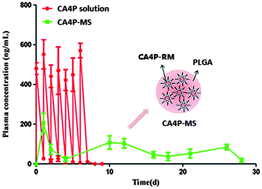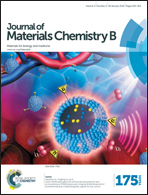Reverse micelles-in-microspheres with sustained release of water-soluble combretastatin A4 phosphate for S180 tumor treatment
Abstract
Combretastatin A4 phosphate (CA4P), the water-soluble phosphate pro-drug of combretastatin A4 (CA4), acts as a novel vascular disrupting agent (VDA). It strongly inhibits tubulin polymerization and selectively exerts action against tumor blood vessels. However, its quite short half-life (∼30 min) results in a short action time and consequently limits its application. Therefore, it is beneficial to develop a sustained-release preparation of CA4P for relatively long action duration. On the other hand, conventional PLGA microspheres display poor encapsulation capability for water-soluble small molecules due to rapid diffusion outside. Hence, we developed CA4P-loaded microspheres (CA4P-MS) composed of methoxy poly(ethylene glycol)-b-polylactide (PELA) reverse micelles and PLGA with a nano-in-micro sea-island structure. The CA4P encapsulation efficiency of CA4P-MS reached 92.88%. More interestingly, sustained drug release was achieved, which contributed to the prolonged inhibition effect on S180 tumor during a 30-day period with one-time subcutaneous administration. In conclusion, our study established a biodegradable polymer based platform to construct microspheres for water-soluble small molecular compounds with sustained release and a long-lasting action.


 Please wait while we load your content...
Please wait while we load your content...